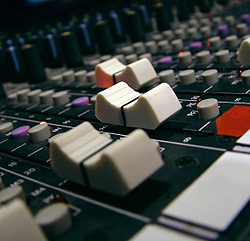
The manufacturer figures that you’re going to plug in mic “A” and mic “B”, and you’ll place them on these various instruments or voices; then a ballpark gain setting is chosen that should serve the needs of all of the inputs. (That fixed resistor costs about one-tenth as much as the pot – multiply that times one for each channel.)
However, the trade-off for lower cost is flexibility. For example, you might decide that you get the best sound if you mic a certain instrument in a certain way. If the incoming signal is too hot or too soft, you could use that sensitivity control to adjust for the difference.
Without that control, creativity is required, i.e., what’s another way to drop the strength of the signal coming into the console on a particular channel? One could move the mic farther from the instrument.
The main path of the signal goes next to the equalizer section of the channel. This is really just a glorified volume control which allows you to turn the sound up or down in various frequency bands. Your intent should be to improve the tonal quality of a particular voice or instrument.
Remember to be subtle with EQ adjustments. A small EQ change can make a huge improvement in the quality of a person’s voice. But there are times when altering EQ is simply not needed. Part of a mixer’s job is to know the difference, and then to not twiddle the EQ knobs just because they’re there.
Hip Terminology
The signal then flows on to the channel fader. Fader is the hip term – I want all of you to be hip, so stop using the term “slider”.
Here’s where most of the action of the mix happens. The fader provides the means to make adjustments in the balance of each voice or instrument during the song or sketch.
Faders generally have a logarithmic taper; that is to say, the rate that the volume changes will vary along the throw of the fader.
For example, a 1/4 of an inch move of the fader near the top of its travel may account for a 5 dB change in level, whereas the same 1/4 of an inch move of the fader near the bottom of its travel may account for a 20 dB change in level.
As a result, the mix will be smoother and quieter if the faders are operated in the upper one-third of their travel for the most part. This deals with gain structure; hang on, we’ll get to that point soon.
Now our signal path is at the summing point. The Greek Sigma symbol with a circle around it is a common notation for a “summing” or “combining” point.
The signal flow diagram here shows just one channel of the console, but let’s say that we’ve really been talking about a 16-channel console. Each channel is identical up to this point, and then they all combine or sum.
